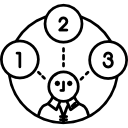UML: Difference between revisions
Mr. MacKenty (talk | contribs) No edit summary |
Mr. MacKenty (talk | contribs) No edit summary |
||
| Line 12: | Line 12: | ||
* [https://msdn.microsoft.com/en-us/library/dd409437.aspx Please review this excellent resource on UML] | * [https://msdn.microsoft.com/en-us/library/dd409437.aspx Please review this excellent resource on UML] | ||
* [https://www.uml-diagrams.org/index-examples.html Please review this example page of UML diagrams] | * [https://www.uml-diagrams.org/index-examples.html Please review this example page of UML diagrams] | ||
== A helpful video == | |||
<html> | |||
<iframe width="560" height="315" src="https://www.youtube.com/embed/UI6lqHOVHic" frameborder="0" allow="accelerometer; autoplay; encrypted-media; gyroscope; picture-in-picture" allowfullscreen></iframe> | |||
</html> | |||
== References == | == References == | ||
Latest revision as of 07:49, 8 May 2020

Computational thinking, problem-solving and programming[1]
The Unified Modeling Language (UML) is a general-purpose, developmental, modeling language in the field of software engineering, that is intended to provide a standard way to visualize the design of a system.[2]
Please watch this linked youtube video for a friendly introduction to UML.
Class Diagrams[edit]
A UML class diagram describes the object and information structures used by your application, both internally and in communication with its users. It describes the information without reference to any particular implementation. Its classes and relationships can be implemented in many ways, such as database tables, XML nodes, or compositions of software objects.[3]
- Please review this handout on UML
- Please review this excellent resource on UML
- Please review this example page of UML diagrams
A helpful video[edit]